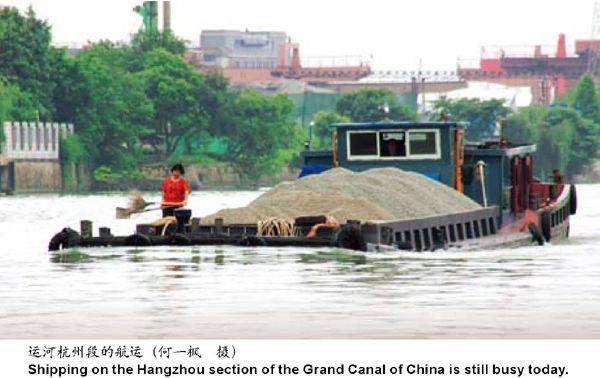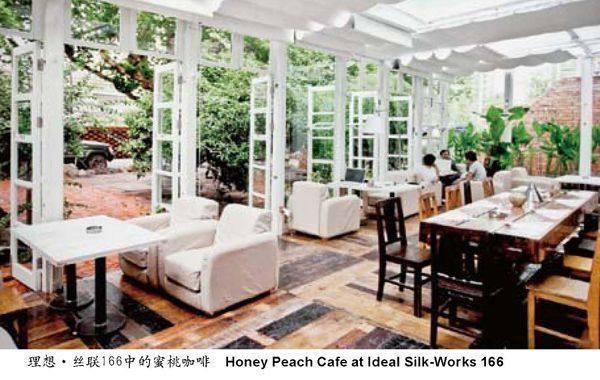古璞映輝
栗子



今天,無論是乘船駕艇從運河上經過,還是沿著運河岸漫步,縱目四望,處處都可以看到千年古運河所留下的橋梁、堤壩、船塢、碼頭、漕倉、貨棧、街巷、民居。每一景一物都積淀、鐫刻著歷史的滄桑、時代的變遷;每一木一石都閃映出歲月古老而厚重的光澤。
在杭州拱墅區,運河流經至此,為創意產業的發展提供了肥沃的文化土壤。于是,運河天地文化創意園由此誕生,一路沿河,擁有包括LOFT49、創意產業園、樂福智匯園、華源創意工廠、浙窯、創意橋、建華文創園、A8藝術公社、富義倉園區、理想·絲聯166等10個創意園以及4幢樓宇。
“拱墅區與其他城區發展文化創意產業不同,拱墅區的文化創意產業園區大多在工業遺址上興建,同時與運河旅游發展規劃密切結合,特點十分明晰。”該區有關負責人一語道破了“天機”。
千年運河、曾經依托運河發展的老工業區、嶄新的文化創意產業,三者完美結合,在拱墅區悄然興起了一種文化現象—利用廢棄的舊廠房改造成文化創意的時尚樂園。
建成于2008年5月的理想·絲聯166,位于運河之畔麗水路166號,前身為杭州絲綢聯合印染廠。理想·絲聯166園區建筑面積12000平方米,設有創意工作區、創意展示區、中心廣場、休閑娛樂區四大功能區。行走在金華路上,166的大牌子一眼就能看到。走進去會發現,老舊的廠房隱藏在郁郁蔥蔥的綠色之后,別有一番隱逸風味。
杭城的不少年輕人都是先知道蜜桃咖啡,才了解理想·絲聯166這個地方。作為一個亮點,蜜桃咖啡讓杭州的文藝青年趨之若鶩。白色基調的室內陳設,老廠房的粗糙質感,古典與現代的完美結合,再加上午后的一抹陽光,不得不說這是一個休閑放松的好去處。
在理想·絲聯166里漫步,感受最多的是輕松。上班族愛來這坐著閑聊,或許也是因為這里的輕松,而這樣的輕松里,也不忘帶著一份時尚創意的氣息。
同樣,傳統文化、運河遺存、民眾互動,這三者的完美結合,也為杭州運河的古老風味增添了現代活力。
手工藝活態展示館,由民國時期通益公紗廠老廠房改建,于2011年5月開館。其最大特色是,將張小泉剪刀、王星記扇子等老底子的老技藝,從“靜態”展示變成“活態”展示,觀眾能親自參與制作過程,體驗傳統文化。
為進一步豐富非物質文化遺產手工內容,今年5月起,手工藝活態展示館閉館擴容提升,計劃國慶節重新亮相。擴容后,該館面積將擴大一倍,共計3000平方米,入駐的非遺手工藝達到19項。除了原有的張小泉剪刀、王星記扇子、西湖綢傘等杭州老字號以及油紙傘、紫砂、皮雕、剪紙的現場展演內容外,該館還將引入富陽竹紙、桑蠶技藝的生產制作場景,并邀請天竺筷、蛋雕、甌塑等知名的省市級非遺項目參加。該館還將另辟廠房歷史陳列區,展出原杭一棉老工人提供的100多件老物品、老照片,讓觀眾了解百年老廠的歷史與變遷。
杭州拱墅區無疑是運河保護開發做得最為出色的沿岸城區,而這一點同樣也延續到了周邊的城鎮。不遠處,千年佳麗地的古鎮塘棲,也在掀起一股運河現代風。
申遺樣板、運河名鎮、國際旅游綜合體……塘棲影響日盛。其中,水北、水南、市南三大歷史街區已經日趨成熟,江南阿二、丁哥黑魚館以及肯德基等一批知名餐飲和塘棲老字號企業紛紛入駐。
塘棲將目光延伸到水北風情特色街以北的區域,對運河A、B、C、D四個小島進行綜合開發,擬建成具有國際化品牌形象的歷史文化小鎮、具有國際吸引力的主題體驗型旅游產品的國際小鎮。
2012年底,一個名為“新運河·新經濟·新價值”的運河經濟帶發展高峰論壇在杭州舉行。此次高峰論壇的舉行,讓杭州重新審視千年大運河未來的發展機遇。
“杭州是大運河燦爛的明珠,所以大運河是杭州的母親河。”杭州市京杭運河(杭州段)綜合保護委員會副主任倪政剛表示,這十幾年來,運河兩岸發生了翻天覆地的變化,運河的產業從原來過去的航運逐步的走向現代的服務業,包括旅游、生態的,包括其他的文化創意經濟,等等。
中國大運河申遺已經進入了實質性階段,杭州的一段將在不久后的未來成為繼西湖之后又一杭州城市的新名片。如此一來,如何更好地保護和利用運河資源,充分發揮大運河在文化、旅游、經濟和人居等領域的作用,打造獨具活力的運河經濟帶,助力杭州經濟、商貿以及房地產開發業的發展,正成為新的課題。
談到“新”(新運河、新經濟、新價值),或許首先是運河沿岸產業格局的“新”。古運河經濟帶保護開發的產業定位,應當是傳統商貿業與現代服務業的有機結合,其具體的產業方向應該是形成多元、復雜的綜合產業體系。其次是經濟格局的“新”。不能僅僅停留在“航運的河”,而是要向“文化的河”轉變。
相信在“新”的推動下,中國大運河杭州段將展示出更加璀璨的文化。
(除署名外,本文照片由作者拍攝)
Renaissance of Grand Canal in Hangzhou
By Li Zi
Today, the Hangzhou section of the Grand Canal of China looks rejuvenated no matter whether you take a boat tour on the canal or take a stroll along the canal. What has been left over from the glory and glamour of the Grand Canal are still there: bridges, levees, docks, piers, barns, warehouses, streets and lanes, residential houses. Gongshu District of Hangzhou is a typical area which once prospered thanks to its geographical advantages created by the canal. Nowadays, the old canal zone is ten creative cultural sites such as LOFT49, the Creative Industrial Park, Lefu Smart Zone, Huayuan Creative Factory, Zhejiang Kiln, Fuyi Granary Zone, Silk Works 166. Also on the canal are four high-rise modern buildings.
Unlike cultural businesses in other districts of the city, the above-mentioned cultural businesses in Gongshu District are located in the old factories which used to flank the Canal. The blueprints for these cultural businesses were developed in conjuncture with the blueprints of local tourism. With these blueprints, Gongshu District has turned quite a few factory houses into incubators of creative ideas, art, and fashion.
Aspiration-Silk Work166 is situated at 166 Lishui Road on the Grand Canal. The site used to house a large silk dyeing business. In 2005, the factory workshops, which measure 1,2000 square meters of built-up area, were turned into four sections: work, display, entertainment and a central square. What makes the zone stands out is a big logo and many trees left over from the past. For many young people in Hangzhou, it is Peach Cafe in Aspiration-Silk Work166 that allured them first to the new site. Featured in white and a feeling of industrial house lost in history, youngsters love to hang out there, enjoying afternoon sunshine and a cup of coffee.
Also located in the area are some museums which highlight traditional culture and ancient canal-centered lifestyle. Handicrafts in Action, a museum situated in the previous workshops of a yarn-spinning factory, was founded in May 2011. The major crafts on display are Zhang Xiaoquan scissors and Wang Xing Ji paper fans, two traditional handicrafts of Hangzhou. Visitors can see the best products and they can view how craftsmen make scissors and fans on the spot. The museum also provides a hands-on experience. In May, 2013, the museum closed its door for an expansion project. The project is slated to conclude in October, 2013. It will expand to 3,000 square meters and 19 kinds of handicrafts, which are also intangible cultural heritages, will be exhibited. Masters will be there to demonstrate the traditional procedures and techniques. One section of the museum exhibits about 100 photographs highlighting the life and work of the Hangzhou First Cotton Textile Factory.
Tangxi, a canal zone in a northern suburb of Hangzhou, is now experiencing a renaissance as as a canal town. In association with the application campaign for acquiring a world heritage status and with international tourism featuring canal features, Tangxi now presents three historical streets. A few domestic and international restaurant chains have gravitated toward Tangxi. Tangxi is going to develope four isles to attract international tourists.
At the end of 2012, a development forum was held in Hangzhou, featuring the theme “New Canal, New Economy, New Value”. It examined development opportunities for the millennium-old canal district in Hangzhou, with a focus on economic potentiality in the canal zone and regional economic growth in the next decade.
Thanks to the development over the past 10 plus years, the canal is no longer shipping centered. It is now home to a modern tertiary industry specialized in tourism, ecology and creative cultural businesses.
The development strategy for the canal-zone is the latest urban development phase of Hangzhou: The past two development phases have been around the West Lake and across Qiantang River.
At present, the application for acquiring a world heritage status for the Grand Canal of China is at a substantial stage. It can be imagined that granted the status, the Hangzhou section of the Grand Canal will be another call card of Hangzhou. For the development planners of the city, how to better protect and utilize the resources of the Grand Canal, how to give full play to the role the Grand Canal plays in culture, tourism, economy and human residence, will be a tough task. The city planners are now considering ways to integrate the canal into the city's future.

